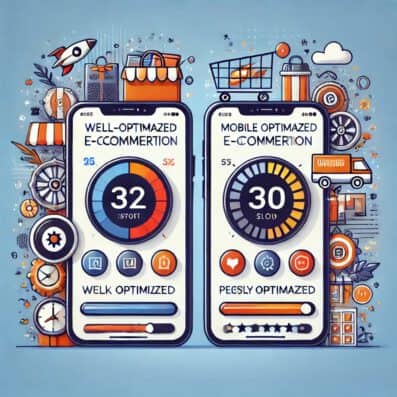1. The Rise of Mobile Commerce
Increasing Mobile Traffic:
- Mobile internet users have surged over the past decade, with mobile devices accounting for more than half of global web traffic.
- Consumers increasingly use smartphones and tablets to browse, research, and purchase products online, making mobile optimization crucial for e-commerce businesses.
Mobile Shopping Behavior:
- Mobile shoppers often exhibit different behaviors compared to desktop users, such as browsing on the go, using voice search, and interacting with mobile-specific features.
- Understanding these behaviors is essential for tailoring the mobile shopping experience to meet user expectations and preferences.
Google’s Mobile-First Indexing:
- Google has put a lot of weight on mobile-first indexing, meaning your mobile version of the site will appear first.
- This shift underscores the importance of mobile optimization for SEO and visibility in search engine results.

2. Benefits of Mobile Optimization
Improved User Experience:
- Mobile optimization ensures that your website is responsive, meaning it adapts to different screen sizes and orientations for a seamless experience.
- A mobile-friendly site enhances usability, making it easy for users to navigate, search for products, and complete purchases on their devices.
Higher Conversion Rates:
- A well-optimized mobile site can lead to higher conversion rates by providing a smooth and hassle-free shopping experience.
- Simplified navigation, fast load times, and easy-to-use interfaces reduce friction, encouraging users to complete their purchases.
Enhanced Customer Engagement:
- Mobile optimization allows for the incorporation of mobile-specific features, such as touch gestures, location-based services, and push notifications, to engage customers more effectively.
- Interactive elements like swipeable galleries and one-click purchasing enhance the overall shopping experience.
Better SEO Performance:
- Mobile optimization contributes to better SEO performance, as search engines prioritize mobile-friendly websites in their rankings.
- Higher visibility in search results can drive more organic traffic to your e-commerce site, increasing the potential for sales.
3. Key Strategies for Mobile Optimization
Responsive Web Design:
- Implement a responsive web design that automatically adjusts the layout and content to fit different screen sizes and devices.
- Use flexible grids, fluid images, and CSS media queries to create a cohesive and adaptable design.
Simplified Navigation:
- Streamline your website’s navigation to make it easy for mobile users to find what they’re looking for quickly.
- Use a clear and concise menu structure, collapsible menus, and prominent search bars to enhance usability.
Fast Load Times:
- Optimize your website’s load times by compressing images, minimizing HTTP requests, and leveraging browser caching.
- Use performance monitoring tools to identify and address any issues that may slow down your site.
Touch-Friendly Design:
- Design your site with touch interactions in mind, ensuring that buttons, links, and other interactive elements are large enough to be easily tapped.
- Avoid using elements that require precise clicks or hover actions, as these can be challenging on touchscreens.
Mobile-Friendly Checkout Process:
- Simplify the checkout process for mobile users by minimizing the number of steps and forms required to complete a purchase.
- Offer guest checkout options, autofill capabilities, and multiple payment methods to reduce friction and cart abandonment.
4. Mobile Optimization Best Practices
Optimize Images and Videos:
- Use high-quality images and videos that are optimized for mobile devices to ensure fast load times and a visually appealing experience.
- Implement lazy loading to defer the loading of off-screen images and videos until they are needed.
Use Scalable Fonts and Icons:
- Choose fonts and icons that scale well on different screen sizes to maintain readability and visual consistency.
- Ensure that text is legible without the need for zooming and that icons are clear and easily recognizable.
Implement Accelerated Mobile Pages (AMP):
- Consider using AMP to create lightweight, fast-loading versions of your web pages for mobile devices.
- AMP can improve page load times and enhance mobile user experience, potentially boosting SEO performance.
Leverage Mobile Analytics:
- Use mobile analytics tools to track user behavior, engagement, and conversions on your mobile site.
- Analyze this data to identify areas for improvement and optimize your site based on user preferences and needs.
Incorporate Mobile-Specific Features:
- Use mobile-specific features such as geolocation, voice search, and push notifications to enhance the shopping experience.
- Use location-based services to offer personalized recommendations and promotions based on the user’s proximity to your physical stores.
5. Case Studies: Successful Mobile Optimization
Case Study 1: Amazon
- Amazon’s mobile app and website are prime examples of successful mobile optimization, offering a seamless shopping experience with features like one-click purchasing, personalized recommendations, and fast load times.
- The company’s focus on mobile optimization has contributed to its dominance in the e-commerce market and high customer satisfaction.
Case Study 2: Starbucks
- Starbucks has optimized its mobile app to provide a smooth and convenient user experience, including features like mobile ordering, payment, and loyalty rewards.
- The app’s intuitive design and personalized offers have driven customer engagement and increased sales through mobile channels.
Case Study 3: ASOS
- ASOS, a leading online fashion retailer, has successfully optimized its mobile site to enhance the shopping experience with features like responsive design, fast load times, and easy navigation.
- The company’s mobile optimization efforts have resulted in higher conversion rates and a strong mobile presence.
6. Future Trends in Mobile Optimization
Voice Commerce:
- With the growing popularity of voice assistant apps like Alexa, Siri, and Google Assistant, optimizing for voice search is becoming increasingly important.
- Ensure that your mobile site is voice-search-friendly by using natural language and long-tail keywords.
Augmented Reality (AR) and Virtual Reality (VR):
- AR and VR technologies are being integrated into mobile shopping experiences to provide interactive and immersive product views.
- Implementing AR and VR features can enhance the mobile shopping experience and boost customer engagement.
Artificial Intelligence (AI) and Personalization:
- AI-driven personalization can deliver tailored content and product recommendations based on user behavior and preferences.
- Leveraging AI for mobile optimization can improve the shopping experience and increase conversion rates.
Conclusion
Mobile optimization is no longer optional for e-commerce businesses; it is a necessity in today’s mobile-centric world.
By prioritizing mobile optimization, businesses can provide a seamless and engaging shopping experience, improve conversion rates, and enhance their overall online presence.
Implementing key strategies and best practices for mobile optimization will ensure that your e-commerce site remains competitive and meets the evolving needs of mobile consumers.
As technology continues to advance, staying abreast of emerging trends and innovations will be crucial for sustained success in the mobile e-commerce landscape.
Benjamin Shemesh is an ecommerce enthusiast and a digital marketing expert.
He loves surfing the ocean
